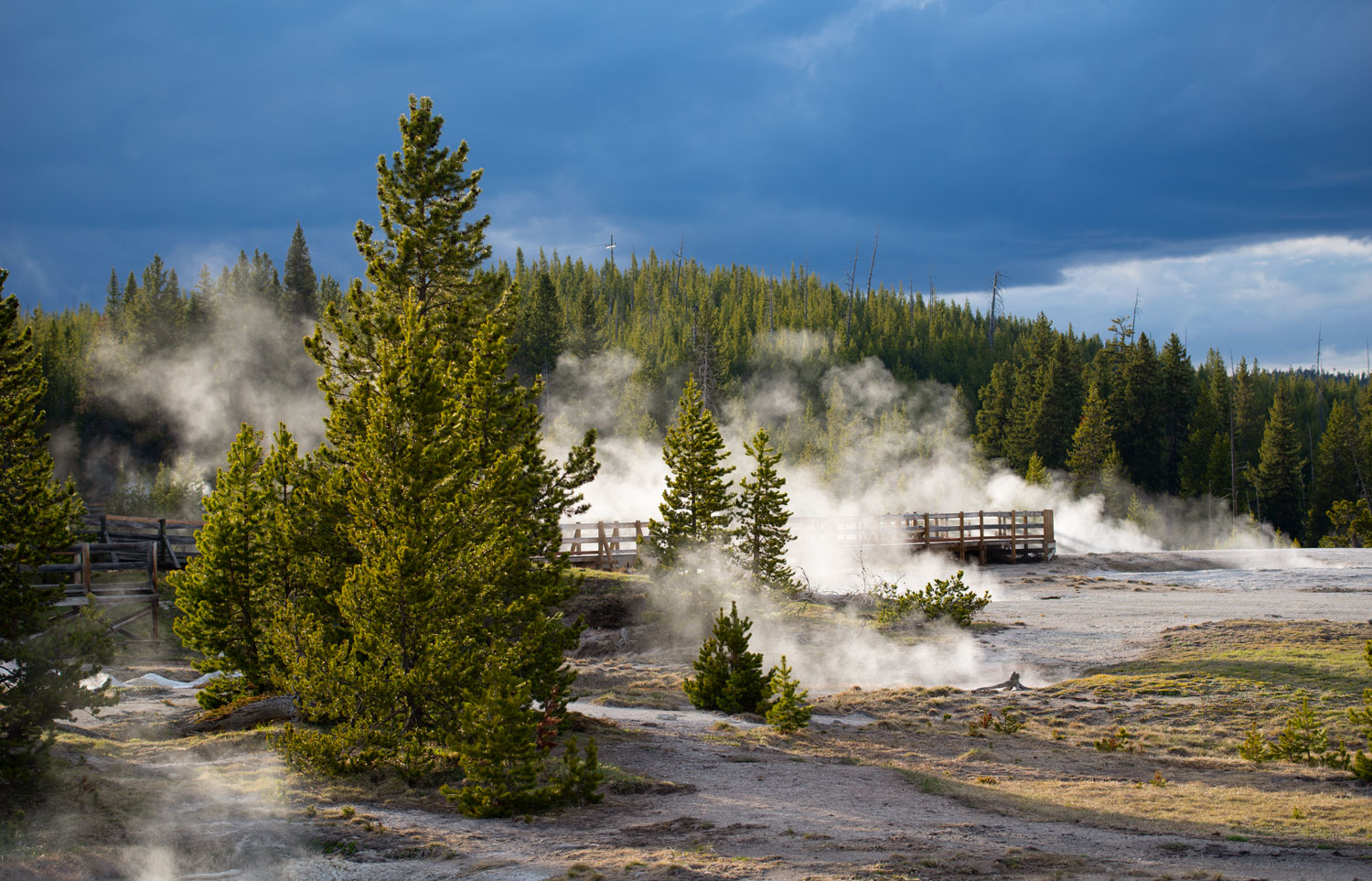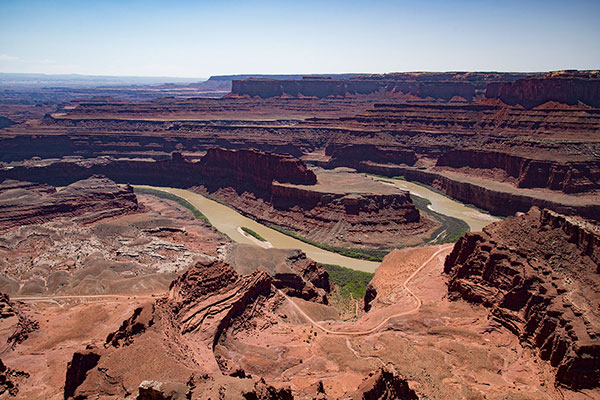Yellowstone Roars Back To Life
Photos by Forrest Anderson
Yellowstone National Park has roared back to life as its annual summer opening has coincided with the waning of the pandemic.
On Memorial Day weekend, every entrance to the park had double-digit increases in number of entering vehicles. The weekend brought in 43,416 vehicles compared to less than 29,000 in 2019. Large crowds continue to visit the park since the holiday, gathering at Old Faithful, in the gift shops and restaurants and along roads to photograph buffalo, elk and the occasional bear.
The crown jewel of the U.S. national park system, Yellowstone typically receives more than 4 million visitors annually from all over the world. It was the second most visited U.S. national park in 2020 behind Great Smoky Mountains National Park.
The park’s main attraction is the geysers, mudpots, and bubbling hot springs that make up more than half of the globe’s geothermal features.
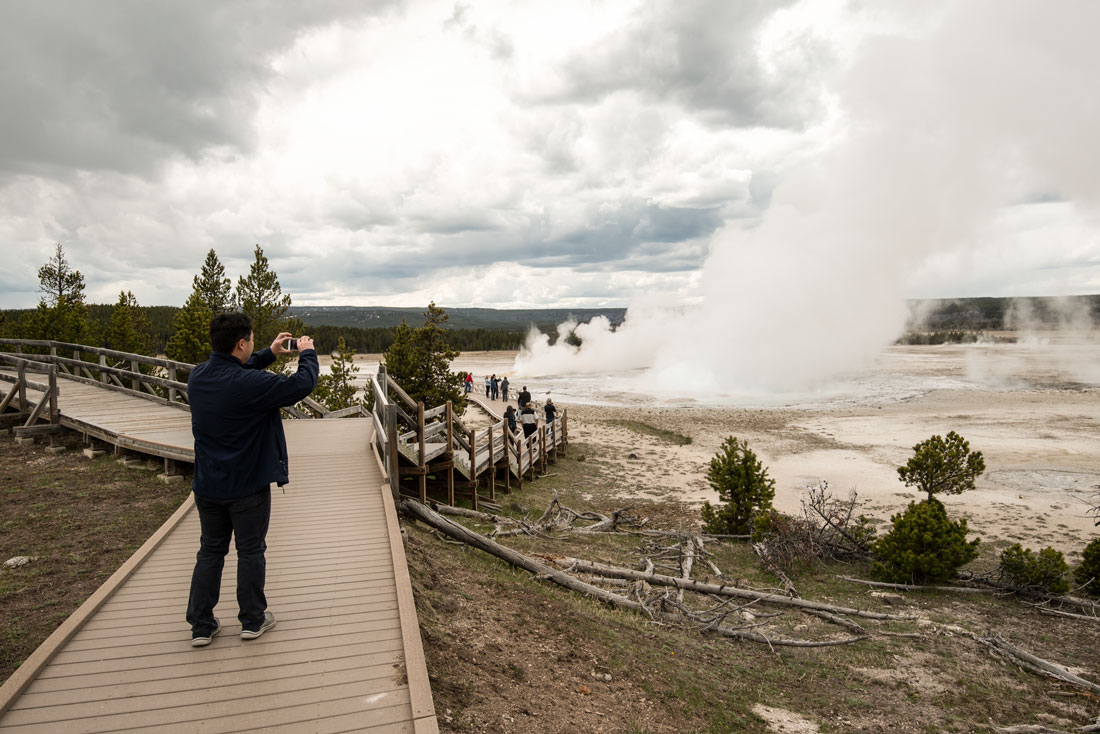
Yellowstone also is the core of one of the largest nearly intact temperate zone ecosystems on the planet. The park and federal and state lands that surround it, called the Greater Yellowstone Ecosystem, have basically the same plants and animals that they had before Europeans arrived on the scene in the 18th century. The ecosystem is home to the largest concentration of large animals such as buffalo, grizzly, moose and elk in the contiguous 48 states.
The park itself covers 12 to 18 million acres in Wyoming, Montana and Idaho, while the larger ecosystem includes about 22 million acres.
While the United States is deeply divided on environmental issues, the park’s central mission and brand is conservation to the point that the word Yellowstone has become an international synonym for environmental protection.
The National Park Service protects the geothermal and natural features and wildlife in the park with strict restrictions on visitor behavior. Throwing anything into the fragile geothermal features or other natural areas of the park or stepping off boardwalks in geothermal areas can result in heavy penalties.
The public is widely supportive. When a man whose goal it was to hit a golf ball in all 50 states teed off recently in Yellowstone, bystanders pounced, posting videos of the stunt on Instagram along with angry comments. Park officials tracked the golfer down in California to inform him that he could face a $5,000 fine and six months in jail.
“The individual who recently was captured on video hitting golf balls in Yellowstone National Park showed a lack of judgment and common sense,” a statement released by Yellowstone read. “He violated regulations designed to preserve Yellowstone and protect the experience of other visitors. The National Park Service is investigating this illegal act.”
The Caldera
In the center of the park is the Yellowstone Caldera, the largest “supervolcano” in North America. The volcano is dormant, but has erupted with tremendous force several times in the past two million years and most of the park is covered with lava flows and rocks from the eruptions.

A hot spring in one of the geothermal basins in the park.
The park has one of the world's largest petrified forests, made up of trees that were buried by ash and soil in those events and transformed from wood to mineral.
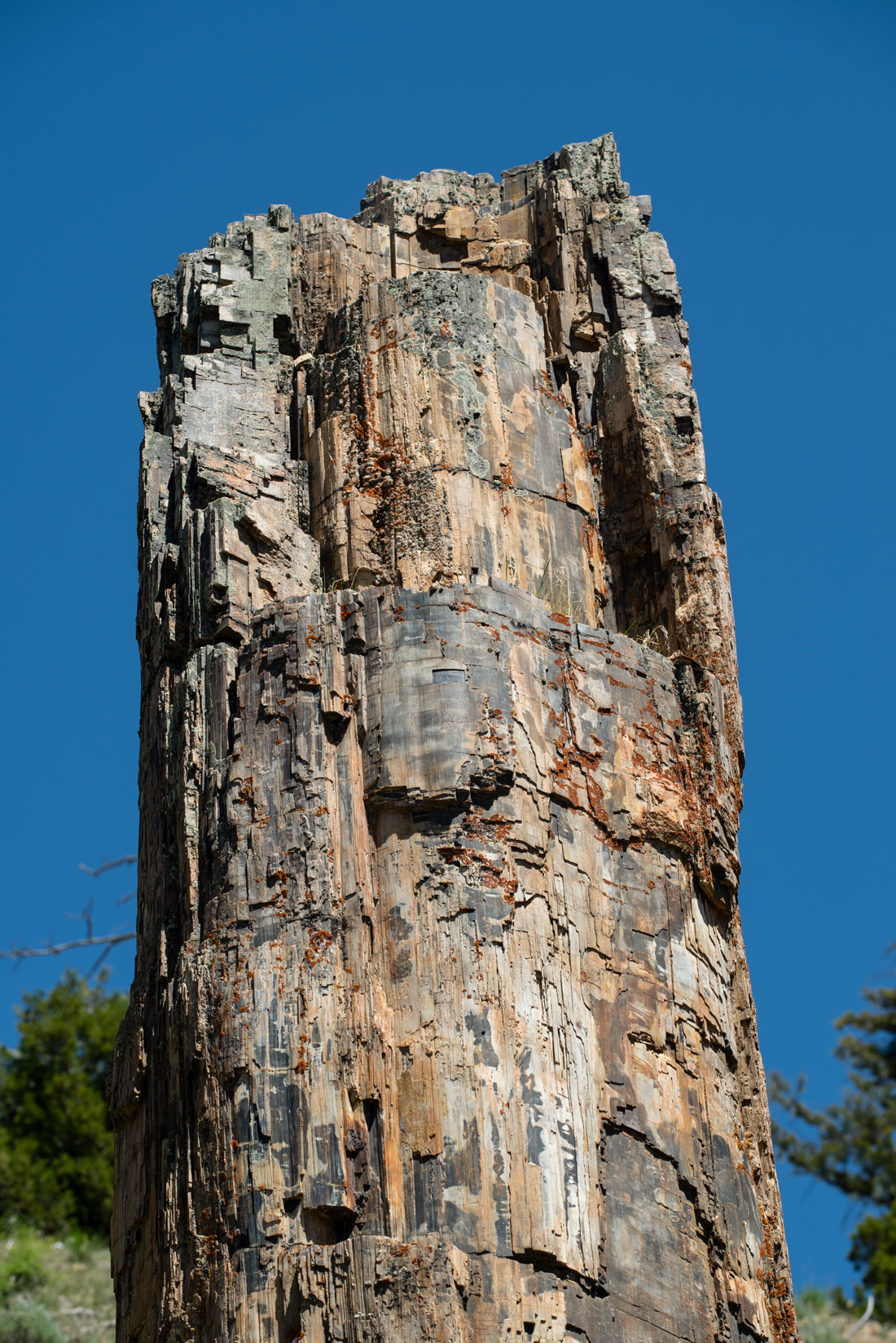
A petrified redwood tree in the park.
Under Yellowstone is a hotspot that remains stationary while the North American tectonic plate moves west-southwest over it. The magma chamber that lies under Yellowstone is an estimated 37 miles long, 18 miles wide, and 3 to 7 miles deep. The YellowstoneCaldera was created by a cataclysmic eruption 640,000 years ago that released more than 240 cubic miles of ash, rock and pyroclastic materials. More than 1,000 times larger than the 1980 eruption of Mount St. Helens, it produced the caldera, which is nearly 5/8 of a mile deep and 45 by 28 miles in area. The region also saw a larger eruption 2.1 million years ago, and a smaller one 1.3 million years ago that created other calderas. Each eruption released vast amounts of ash that blanketed much of central North America and probably led to the extinction of some species.
Another eruption almost 160,000 years ago formed a smaller caldera that holds a section of Yellowstone Lake called the West Thumb. Smaller eruptions left behind lava flows in the park area, the most recent about 70,000 years ago. A smaller steam explosion left a crater at Mary Bay on the edge of Yellowstone Lake.
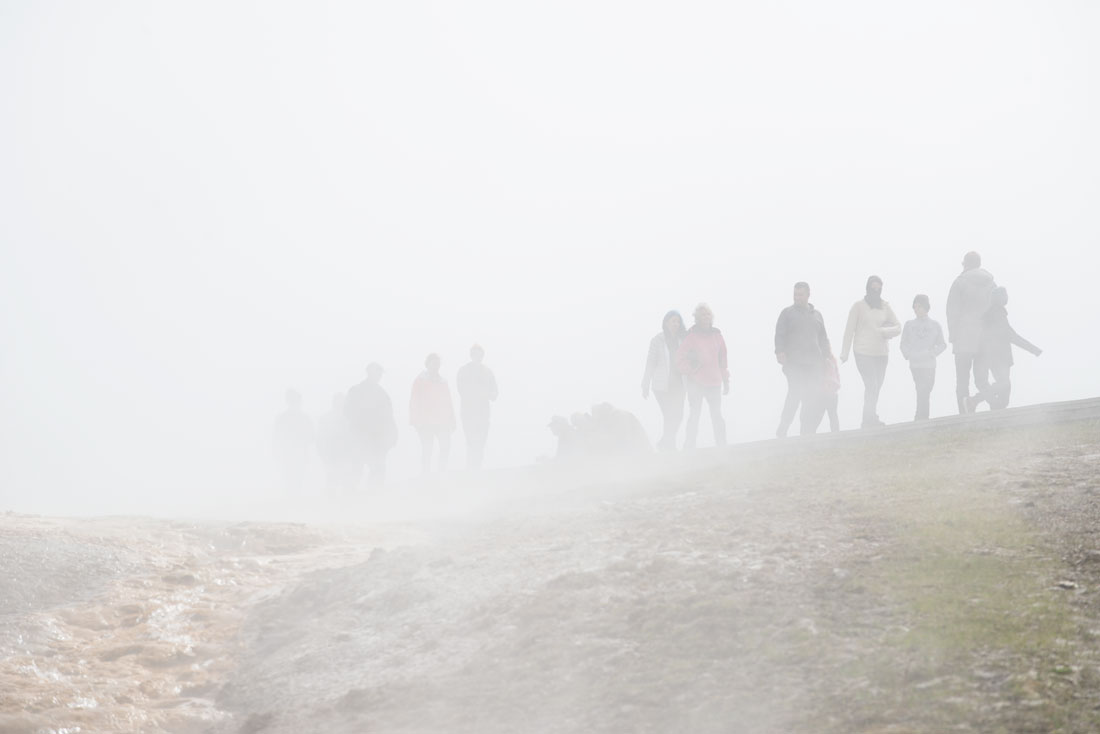
Today, only harmless steam from geothermal features at the park fills the air, obscuring visitors.
Current volcanic activity in the park includes numerous geothermal vents, including Old Faithful Geyser, other geysers, hot springs, bubbling mud pots and ground-swelling that has indicated inflation of the magma chamber. Geologists monitor the rise and fall of the Yellowstone Plateau as an indication of changes in magma chamber pressure.
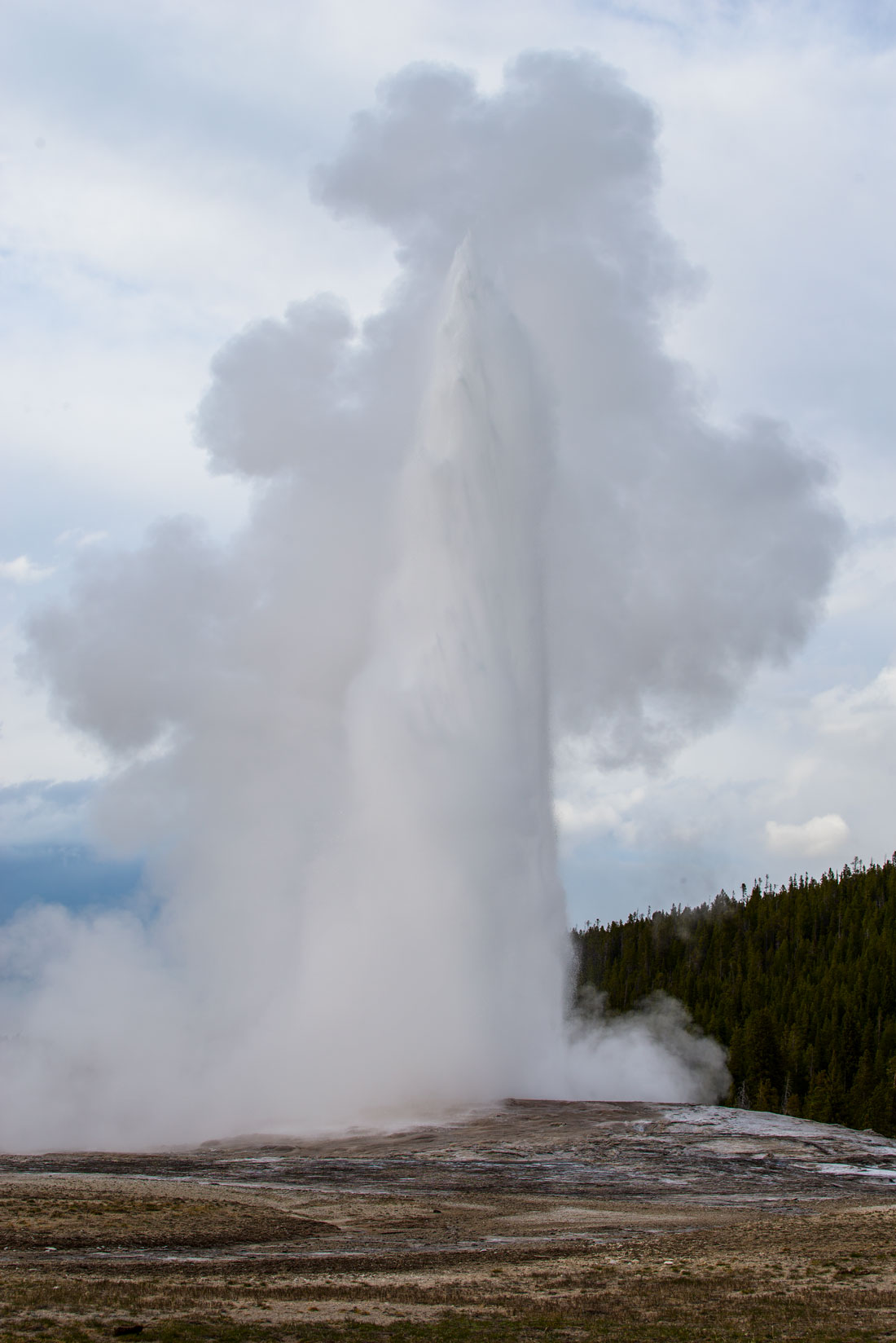
Old Faithful and, below, a bubbling spring, hot spring, and Mammoth Hot Springs, which issues forth hot, acidic water that is constantly remolding the landscape.
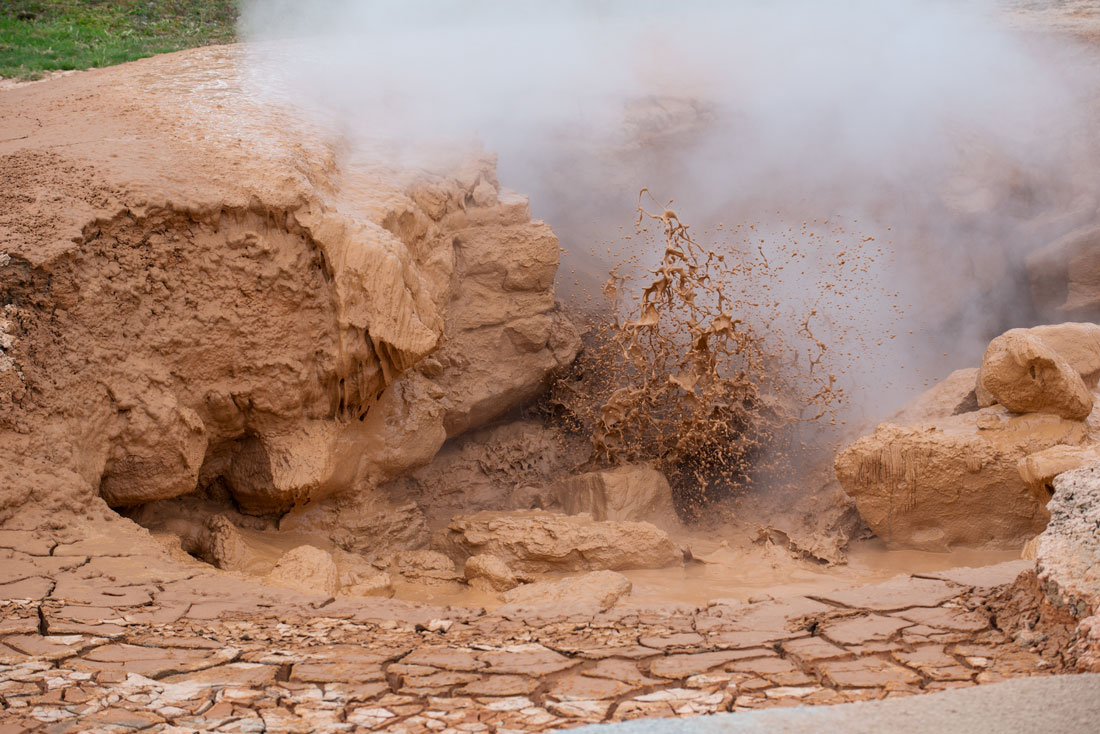
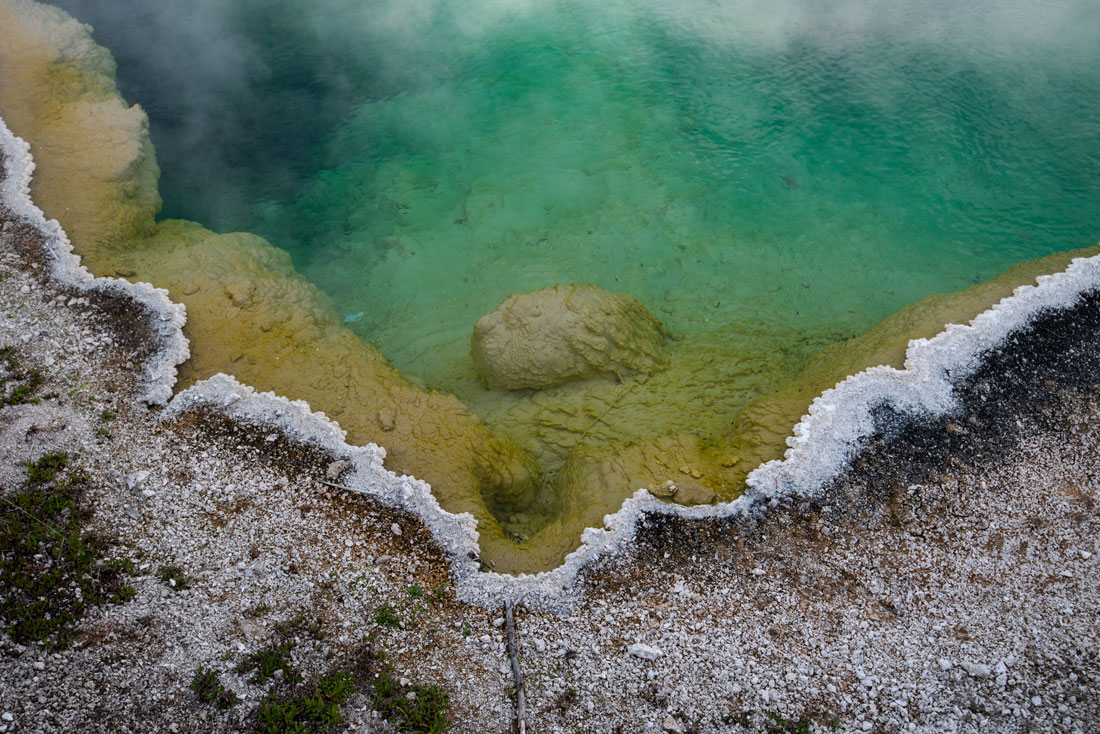
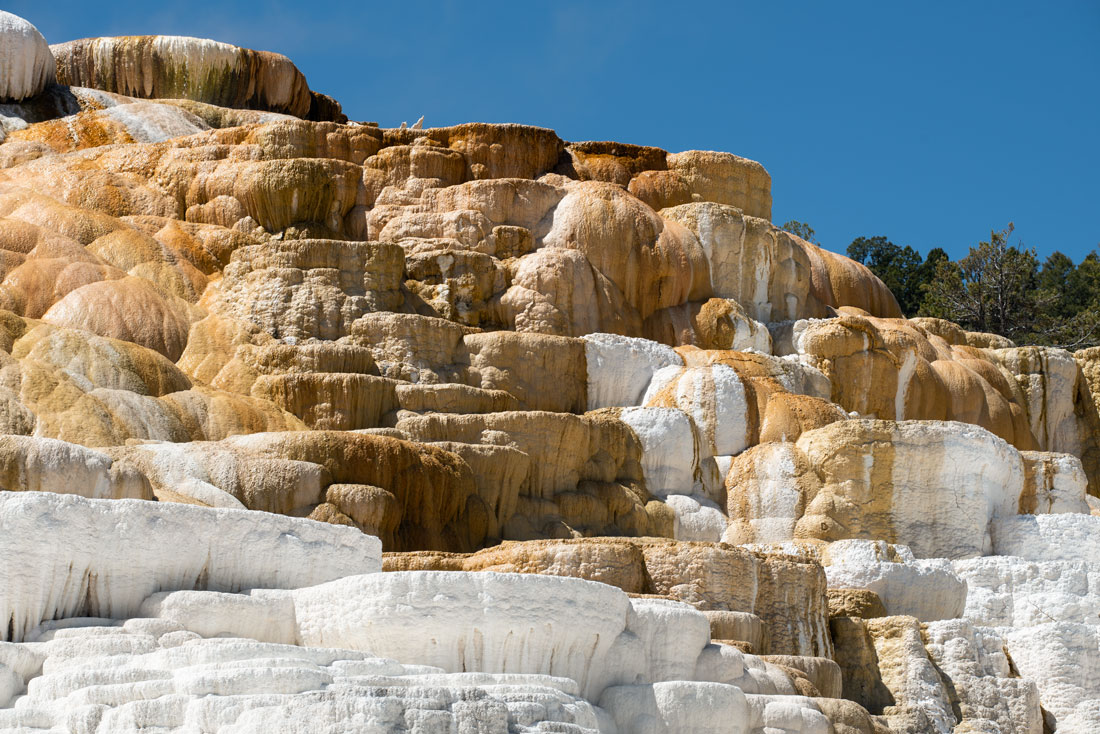
Apocalyptic rumors on social media periodically predict that the Yellowstone volcano is overdue for another massive eruption, which scientists say is nonsense since the volcano has never erupted on any schedule. The U.S. Geological Survey, University of Utah and National Park Service scientists at the Yellowstone Volcano Observatory say they see no evidence that a cataclysmic eruption will occur in the foreseeable future and such an event may never happen.
In a worst case scenario, such an event could bury nearby states in three feet of volcanic ash, damage buildings, kill animals and plants including crops, and shut down power plants as well as spreading some ash to all 48 contiguous states and part of Canada and Mexico.
However, scientists say Yellowstone’s magma chamber is just 6-8 percent filled with molten rock, which they think is too low a proportion to produce a supereruption. The most likely eruption would be a smaller one that produced lava flows such as the one in Iceland and possibly a volcanic explosion and swarm of earthquakes in a specific region of the park. The odds are .00014 percent of the volcano erupting in any given year, lower than the earth getting hit by a civilization-destroying asteroid.
Yellowstone’s magma chamber is just as likely to die if less heat came up from below, turning the chamber to solid granate.
NASA at one point floated the idea of cooling the magma chamber by 35 percent by introducing water into the chamber at high pressure to forestall a supereruption, possibly in such a way that the circulating water could be used as a geothermal power source. The idea wasn’t implemented, partly because it might trigger an eruption.
Volcanic and tectonic action causes between 1,000 and 2,000 measurable earthquakes in the park annually, most minor. Sometimes a swarm happen in a short time, probably caused by slips in pre-existing faults. Distant earthquakes also trigger swarms that can alter the activity of geysers and hot springs in Yellowstone for several months.
The most likely explosive event to occur at Yellowstone is a hydrothermal explosion—a rock-hurling geyser eruption. These are small and occur every few years.
The most famous geyser in the park, and perhaps the world, is Old Faithful. The park has numerous other geysers, including Grand Geyser (the world's tallest predictable one); Giant Geyser, the world's most voluminous; and Steamboat Geyser, the tallest active geyser in the world. Amost 1,300 have erupted in Yellowstone, with an average of 465 active ones in a given year. Yellowstone contains at least 10,000 thermal features.
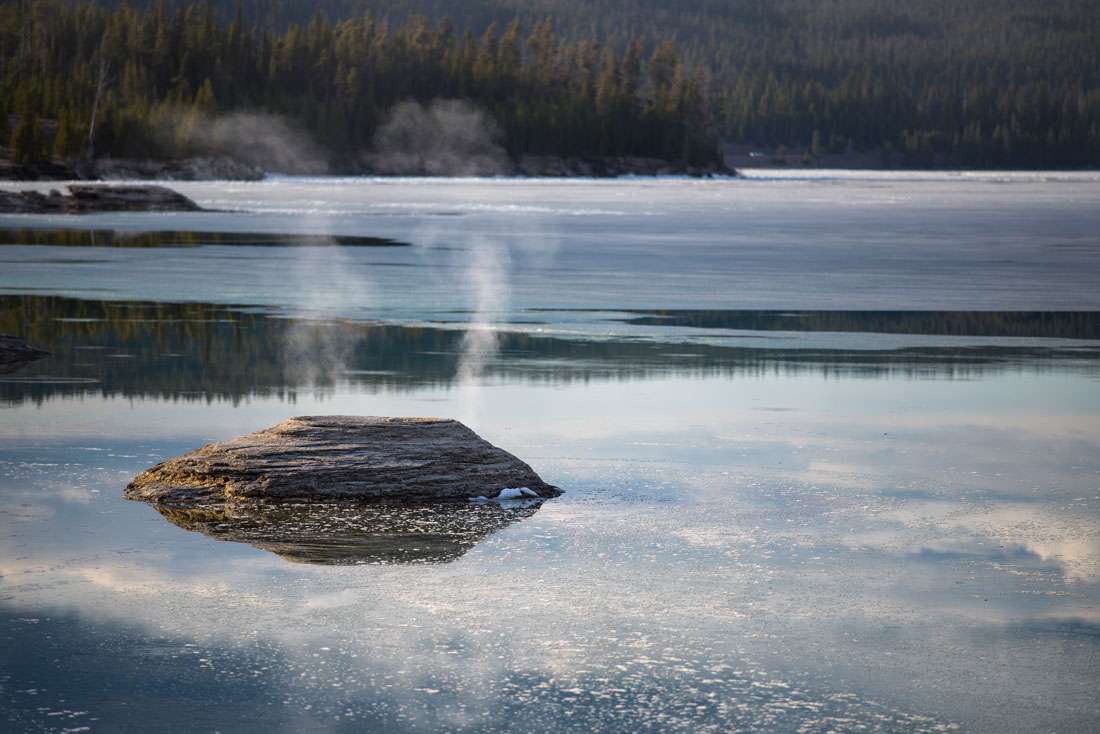
Yellowstone Lake is cold enough to freeze in the winter, but geothermal vents on and near its shores are boiling hot.
The Greater Yellowstone Ecosystem
This ecosystem is home to the largest concentration of large animals such as buffalo, grizzly, moose and elk in the contiguous 48 states of the United States. The ecosystem includes two national parks, most of five national forests, the Absaroka/Beartooth Wilderness, part of Wind River Reservation, three national wildlife refuges, and more than a million acres of Bureau of Land Management land. It covers parts of Wyoming, Montana and Idaho.
The ecosystem has become a flagship for promotion of ecosystem management as conflicts over ecological and resource management have been worked through within the area. It is one of the world’s most important natural ecological and geological laboratories.
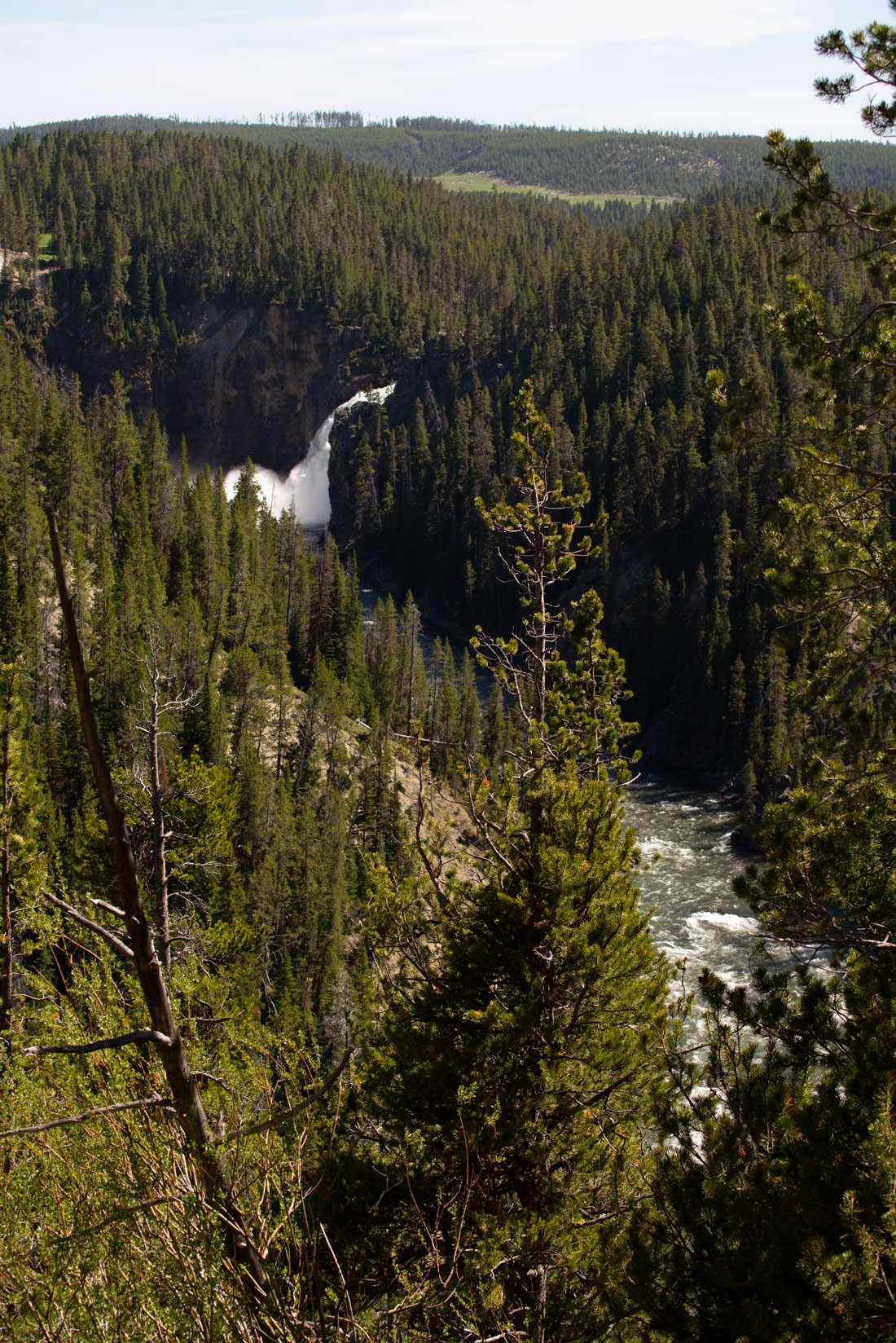
Upper Falls in the Grand Canyon of the Yellowstone.
The ecosystem also is big business, as it is a world-class recreational destination for sightseeing, hiking, camping, boating and fishing that brings $642 million and 7,000 jobs into the local economy. The challenge of ecosystem management is to balance human activities such as recreation, hunting, ranching, logging and development with the ecological health of the region.
This is complex partly because the ecosystem is administered by a variety of national, state, local and private entities, each with their own mandates. The National Park Service manages Yellowstone National Park, Grand Teton National Park, and John D. Rockefeller Jr. Memorial Parkway. The U.S. Forest Service manages Gallatin, Custer, Beaverhead-Deerlodge, Caribou-Targhee, Bridger-Teton and Shoshone national forests. The Fish and Wildlife Service manages the National Elk Refuge, Red Rock Lakes, and Grays Lake National Wildlife Refuges. Ten national Wilderness Areas have been established in the national forests which have higher levels of habitat protection.
A variety of state agencies administer state parks and other state lands. The Trust for Public land protects 67,000 acres in about 40 projects within the ecosystem. All of these entities interface with local governments, ranchers, hunter advocacy groups, and recreational facilities in the area.
The ecosystem also is complex because ecologists are not certain what constitutes maintaining an ecological balance in the area. The park and its surrounding area have gone through a number of historical phases, each of which has been accompanied by differing conservation policies. For the first century, from 1872-1972, the emphasis was on protecting the known geothermal basins in the region. It wasn’t until the 1970s that attention turned to wildlife protection. The grizzly bear’s range became an informal boundary of the ecosystem, which covered 4 million acres. Since then, the ecosystem’s definition has grown to 22 million acres.
Virtually all the original animal species known to inhabit the region when European explorers first entered the area can be found in the ecosystem today. There are 67 species of mammals, including wolves, coyotes, cougars, black and grizzly bears, bison, elk, moose, deer, mountain goats, pronghorns, and bighorn sheep. Some 322 avian species live in the park, of which 148 make Yellowstone their nesting areas. The park has 16 fish species, 10 amphibian and reptile species and more than 12,000 insect species, including 128 butterfly ones. There are 1,150 native vascular plant species. A hundred plant, six fish, amphibians, 20 avian, hundreds of invertebrate and 18 mammal species in the ecosystem are protected.

Buffalo in the park.
Ecologists are continually discovering new information about the wildlife in the ecosystem. For example, the Yellowstone hot springs are home to diverse thermophilic bacteria that have been useful in studies of the evolution of photosynthesis and as sources of thermostable enzymes for replicating DNA in molecular biology. These bacteria can be retrieved with no impact to the ecosystem.
Among the most important plants are whitebark pine. Even relatively minor global warming can dramatically reduce its stands. Fungal rust disease is expected to cause a significant decline in the trees, which are important for grizzly bear habitat. Quaking aspen also has declined dramatically on the park’s northern range.
The grizzly bear population was common when Europeans arrived in the park area. Today, it is an isolated population. There are an estimated minimum 229 grizzly bears in the area, but biologists think there may be as many as 1,000. The population is believed to be close to the numbers when the park was created, but long term habitat loss, climate change and increasing human activities could reverse that trend.
Humans have inhabited Yellowstone, mostly as a hunting ground, for an estimated 11,000 years, and obsidian arrowheads from Yellowstone were traded as far east as the Mississippi Valley. It is difficult to determine the human impact on the environment before the park was created. Since then, the park’s plants and wildlife have been affected by wildfire frequency, regional climate warming because of human activity, hunting, and human settlement on wildlife migration routes.
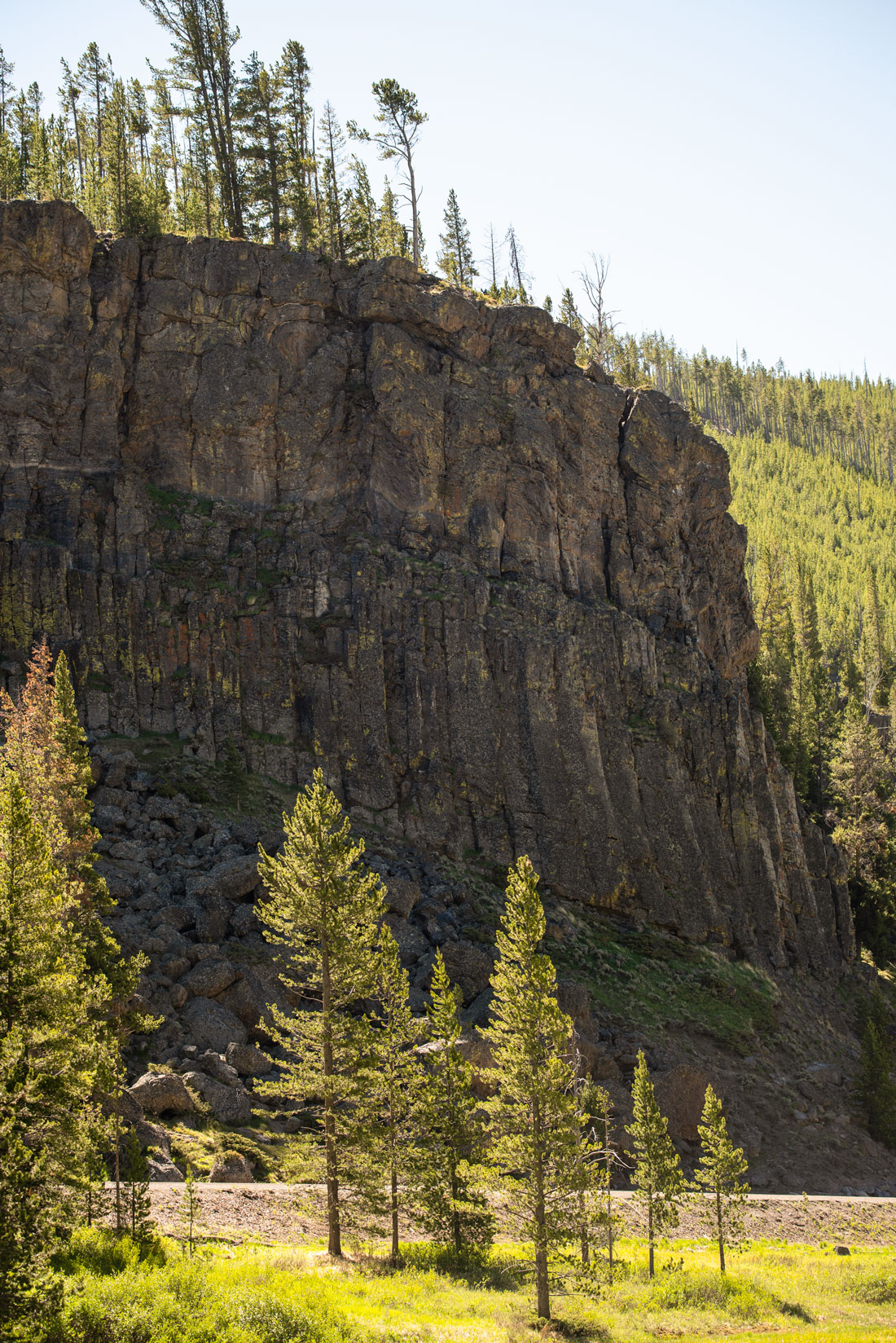
Obsidian Cliff in the park, once the source of obsidian used by Native Americans for arrowheads and other weapon blades.
The Yellowstone cutthroat trout population has considerably declined since Europeans arrived in the area but is flourishing in some areas in recent years because the park service has worked to remove invasive lake trout that eat young cutthroat trout. Cutthroat trout levels still aren’t close to being restored to their historical abundance.
Early explorers in the area described hundreds of pronghorn in major river valleys, but these populations were decimated by the 1900s. There now are about 500 pronghorn.
Before the 1930s, the government made a concerted effort to hunt down and eliminate the gray wolf population. As a result of their main predator being eliminated, the elk population soared and decimated willows and aspens. Yellowstone is home to one of the largest elk herds in North America - more than 30,000. The southern herd’s winter migration is the largest mammalian migration in the United States outside of Alaska.
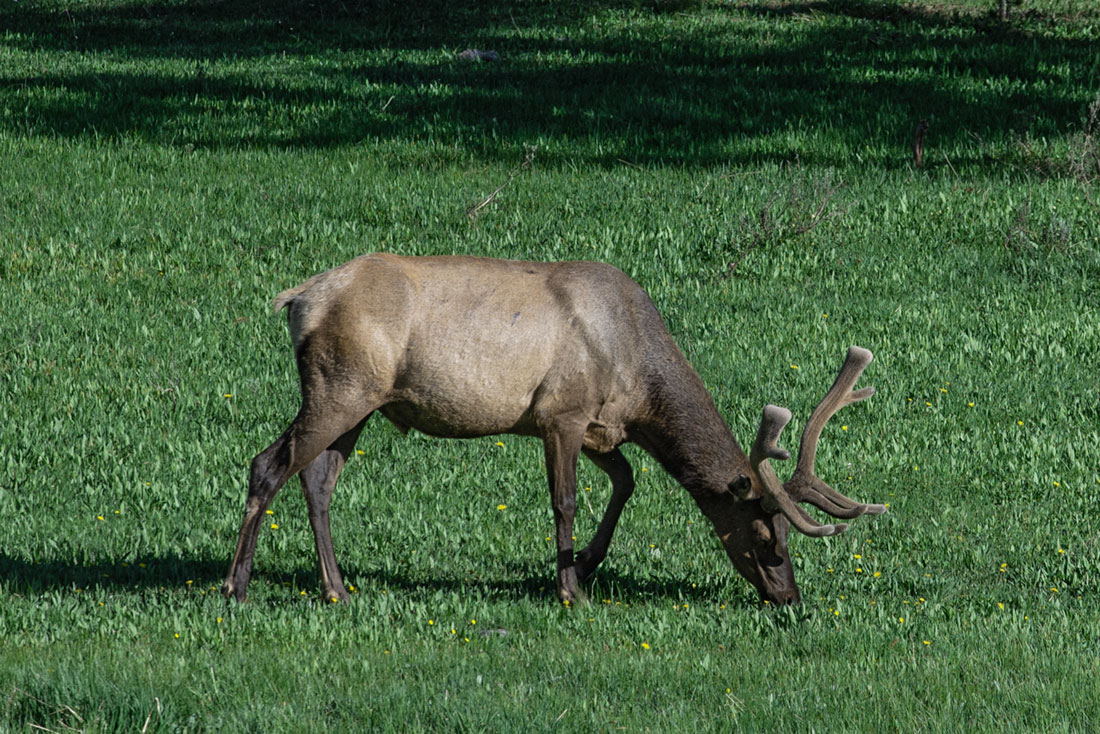
A grazing elk in Yellowstone National Park.
A controversial reintroduction of the gray wolf into Yellowstone in 1995 turned out to be a success in surprising ways. It is rare for biologists to have the opportunity to document the effects of a key species being restored to an ecosystem. They have learned that when wolves are present, elk move into the timber and break up into smaller groups. Elk became less abundant and did not constantly graze riparian zones. As a result, willows and aspens recovered, creating habitat for beaver, moose and many other species. Grizzly bears emerging from hibernation benefited along with other scavenger species, as they scavenged off wolf kills.
The beaver population since has grown from one colony to nine. They build dams and ponds that even out seasonal runoff, store water to recharge the water table and provide cold shaded water for fish. The willows also provide habitat for song birds.
Yellowstone is home to the largest free-roaming bison herd in the United States and is one of the bison’s last strongholds. The park’s herd is one of four free roaming genetically pure herds on public lands in North America. There once were between 30 million and 50 million bison on the continent. Today, the park has about 3,000 bison.
The bison are a concern for ranchers, who fear that bison can transmit bovine diseases to their cattle. There are no reported cases of transmission from wild bison to domestic livestock, but elk have been known to transmit infections to horses and cattle. To prevent this threat, national park personnel regularly corral the bison herds back into the park.
Other less commonly seen mammals include the mountain lion and wolverine. The mountain lion has an estimated population of only 25 individuals parkwide.
Overcrowding, air and noise pollution, displacement of wildlife and safety are important concerns for the ecosystem.
In addition to the natural features, the park has hundreds of protected historical structures and more than a thousand archaeological sites.
Within the park are lakes, canyons, rivers and mountain ranges. Yellowstone Lake is one of the largest high-elevation lakes in North America. The park has 290 waterfalls at least 15 feet tall and three deep canyons.
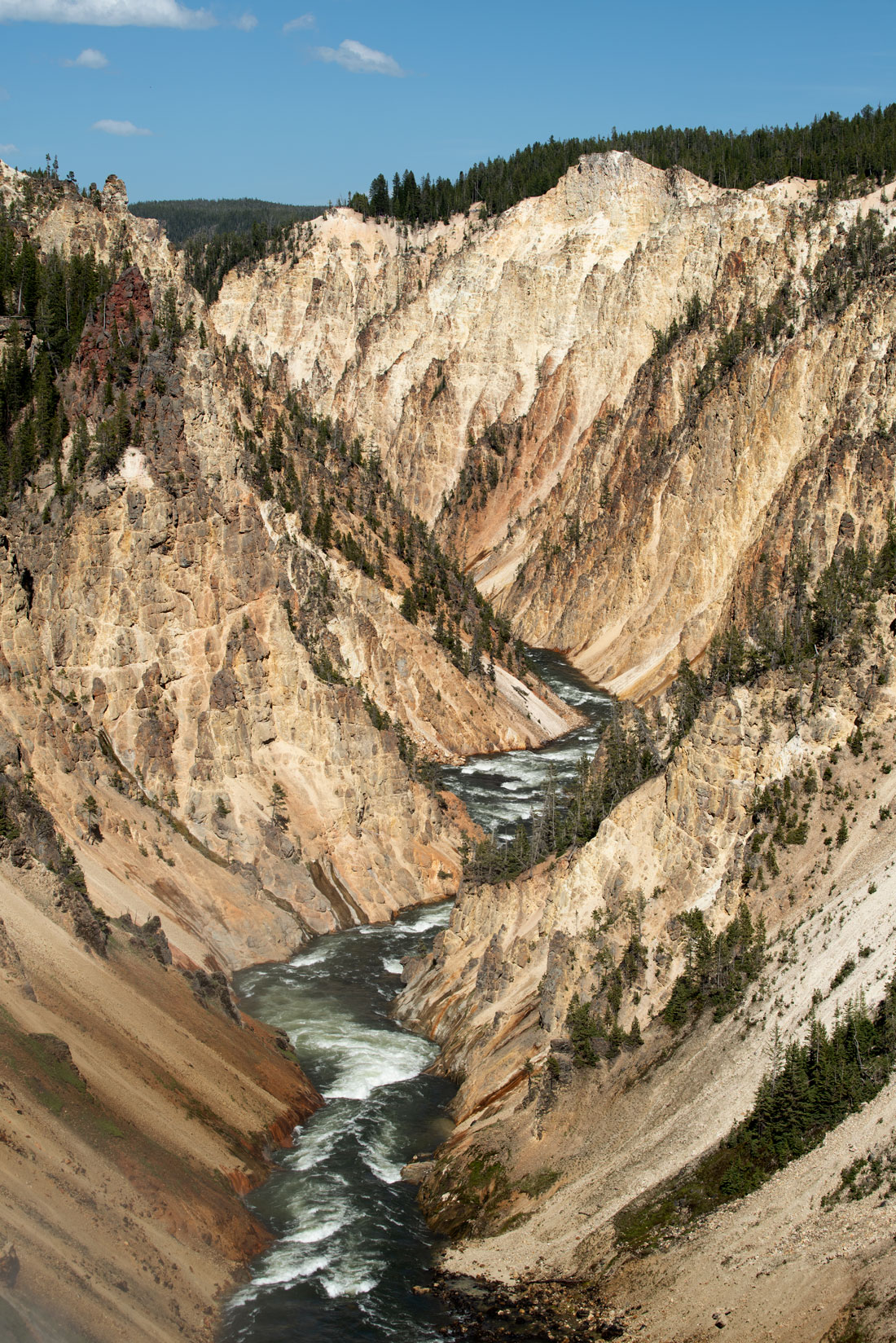
The Grand Canyon of the Yellowstone.
The park is named after Yellowstone River, a name that is believed to have originated with Native Americans who transported it to French trappers, who in turn bequeathed the name to American trappers.
When the first European explorers described the park’s geothermal features, they were thought to be telling tall tales until an 1870 expedition made a comprehensive report. Expedition members convinced the U.S. Congress to withdraw the region from public auction and create the park. A lack of funding, however, still resulted in buffalo, deer, elk and antelope being poached by the thousands for hides.
Native Americans were forced out of the park in the 1870s and 1880s, and the U.S. Army administered it for 30 years until the National Park Service was created in 1916. The park facilities were built in the 1930s-40s by the Civilian Conservation Corps, Many were rebuilt after a 1988 wildfire burned more than a third of the park.
About 35 forest fires are sparked by lightning annually in the area, with another six-ten started by humans. Most are accidents. Few fires burn more than 100 acres, and most burn themselves out when they are a little over an acre. All human-caused fires are doused, while natural ones are suppressed only if they are an immediate threat to people or structures.
Plants in Yellowstone have adapted to wildfire. Douglas-fir have thick bark which protects their core from most fires. Lodgepole Pines have cones that only open by the heat of fire. Their seeds are held in place by a resin that fire melts, allowing the seeds to disperse. Fire clears out dead wood, providing fewer obstacles for lodgepole pines to flourish. Some other species of trees tend to grow in colder, moister areas where fire is less likely to occur. Aspen sprout new growth from roots even if a severe fire kills them above ground.
The management policies are to allow natural processes such as fire, flood, nutrient cycling, competition for resources, and predator-prey interactions to run their course as much as possible unimpeded by human influence.
The notion that national parks should provide snapshots of what the country was like before European humans entered the areas is considered unrealistic because ecosystems are dynamic and it is impossible to reconstruct a landscape in perpetuity. The goal is to create areas where nature and biodiversity can flourish while humans function there and some timber harvesting, hunting and other activities occur.
Because ecologists are constantly learning about the environment, they are constantly changing management strategies. Setting goals for the number of animals in the park doesn’t work, for example, because wildlife managers aren’t certain what optimal animal populations would be.
Some international conservation scholars have claimed that the Yellowstone model is too protectionist and thus doesn’t work for park management in less developed countries. The Yellowstone experience indicates that there is no perfect balance between protecting ecosystems and meeting human needs, but that it is possible to make conservation an enduring feature of the broader economic, social, cultural and political climate. Within the United States are many different national parks and management strategies to balance human desires with the protection of nature. The diverse organizations that participate in conservation of the parks have contributed to them becoming valued by a broad spectrum of Americans who work together to shape an enduring system of natural conservation through negotiation and adaptive management.
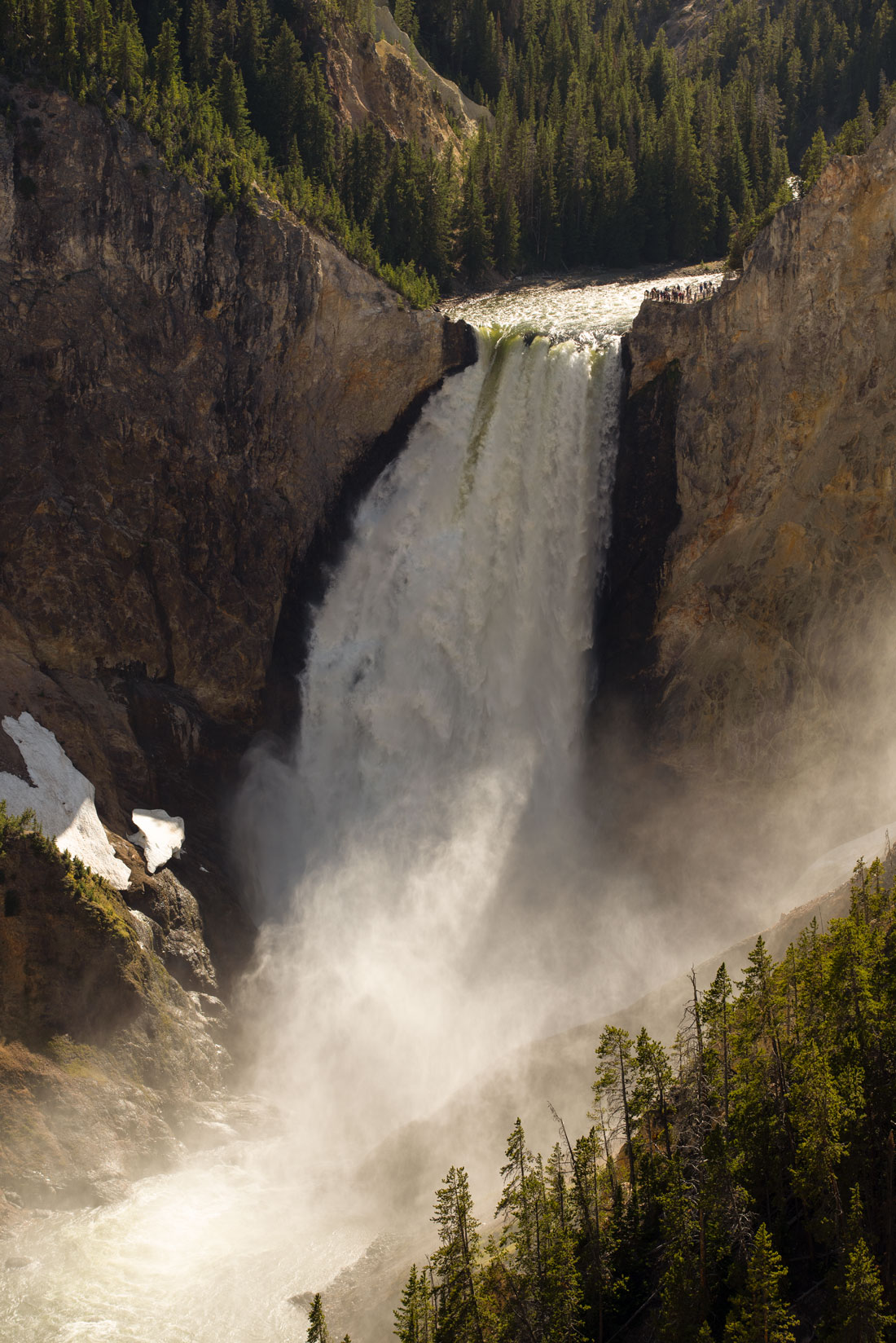
Lower Falls in the Grand Canyon of the Yellowstone, with a crowd on a nearby overlook. The great challenge of the Greater Yellowstone Ecosystem is maintaining a balance between nature and human activity in the area.
Check out these related items
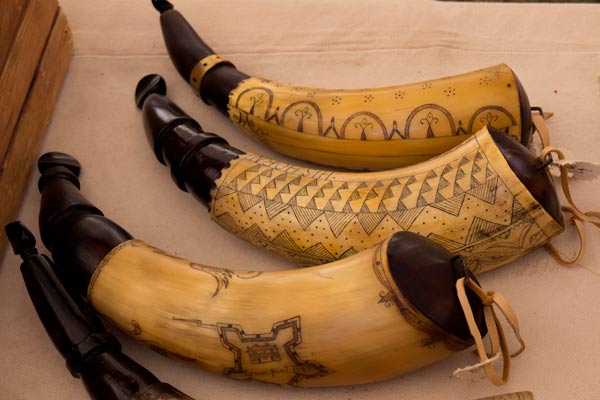
Mountain Men and the Fur Trade
The colorful annual mountain men rendezvous at Fort Bridger, Wyoming, commemorates the 19th century global fur trade.
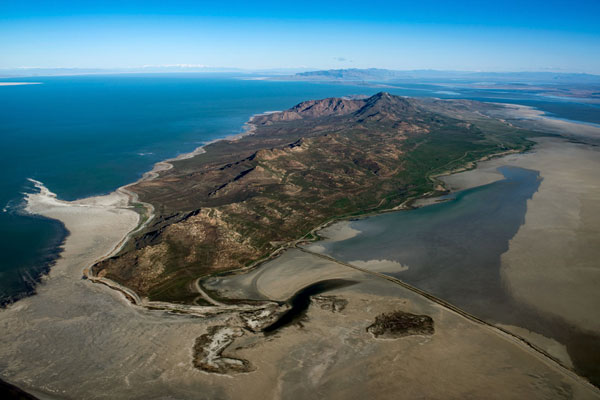
Saving the Great Salt Lake
The Great Salt Lake, along with other saline lakes worldwide, is drying out. Preserving and restoring won't come cheap.
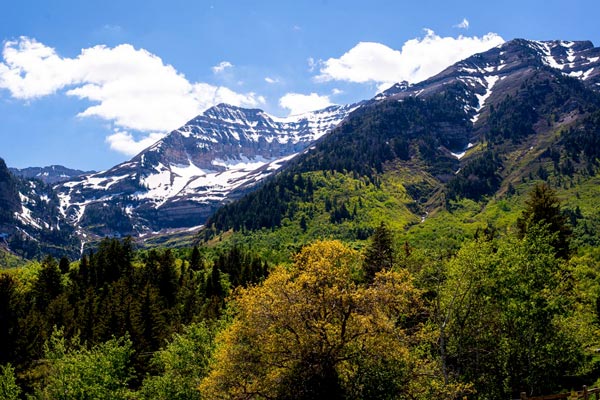
Springtime in the Rockies
It's springtime in Utah's Rockies. Photographer Forrest Anderson captured the stunning scenery.

The River That Keeps on Giving
The mammoth Colorado River is the lifeblood of the southwest United States, supplying water and power for cities and agriculture.
